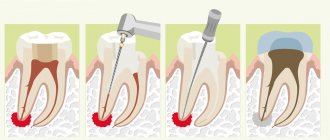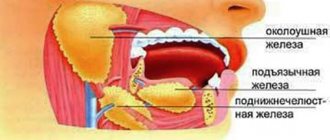This is a fairly rare disease that affects men between 30 and 60 years of age who are sexually active. At this age, the genital organ is more susceptible to microtrauma, including during sex. In men over 60, the disease is rare due to decreased sexual activity. The disease is named after the man who first described it in 1743. During Peyronie's disease, a man's penis becomes curved due to progressive fibrotic changes in its tunica albuginea.
Peyronie's disease (normal and curvature)
Photo: Patient with Peyronie's disease (Source: ru.wikipedia.org)
Nature and causes of Peyronie's disease
For a long time, experts believed that Peyronie's disease was endocrine in nature, and therefore they tried to treat the disease using hormones from the pituitary gland, adrenal glands and parathyroid glands. However, subsequently, experts increasingly began to be inclined to believe that the curvature of the penis is caused by injuries, for example, during forced sexual intercourse.
Among the reasons are the following:
- a wide range of injuries to the genital organ, for example, during sexual intercourse, from a blow or an accidental fall on a hard surface;
- microtraumas that are invisible to the eye and not accompanied by pain. They often occur during sexual intercourse;
- closed fracture of the penis, in which the integrity of the skin is not violated, but hemorrhage occurs;
- abnormalities of the immune system;
- diabetes;
- taking medications;
- the presence of narrowing of the lumen of blood vessels, which is characteristic of a disease such as atherosclerosis;
- a wide range of connective tissue diseases;
- gout – an increase in the level of uric acid in the blood;
- deficiency of vitamin E and calcium in the body;
- increased levels of serotonin in the body;
- the man's age. As the body ages, tissues lose their elasticity and are more susceptible to injury.
The role of a hereditary factor in the genesis of Peyronie's disease cannot be excluded. At a minimum, this is evidenced by Dupuytren's contracture, which occurs in more than half of patients with Peyronie's pathology.
Classification and types of disease
Peyronie's disease can lead to three types of penile curvature: dorsal, ventral, lateral. In the first case, the penis in men “looks” upward; with ventral deviation, it is directed downward, and with lateral deviation, the lateral deformation of the penis is called. Treatment is not required if the curvature is mild, is not associated with pain and does not interfere with sexual intercourse.
Depending on the stage of its progression, Peyronie's disease is divided into:
- pain – men complain of severe pain not only during an erection, but also at rest. Only in isolated cases does the manifestation of pain not bother men, and the reason for contacting a doctor is a well-palpable plaque. Often its size does not exceed two centimeters;
- functional - in addition to causing pain, such an illness leads to the inability to lead a normal sexual life.
Since Peyronie's disease has a very high tendency to progress, self-diagnosis and, especially, self-medication are unacceptable here. If pain occurs in the head and body of the penis, you should immediately consult a urologist. Only at this stage is consultation with this specialist effective and can prevent the disease.
What can cause a testicle to increase in size?
The average width of the testicles varies from 2.5 to 3.5 cm, length - from 4 to 6 cm. Normally, one is located slightly higher than the other, which is due to physiology: different origins of the arteries of the testicles, as well as the need to protect the testicles from injury and overheating due to the tight fit. Possible causes of testicular enlargement include:
- benign tumors;
- malignant tumors;
- varicocele;
- testicular torsion;
- hernia in the groin;
- epididymitis.
Benign tumors
One of the causes of swollen testicles in men is benign neoplasms. They are typical for middle age. The tumor can be felt independently, most often on the back surface of the testicle. There may be several neoplasms; they can be located on both sides of the testicle. There are several types of tumors:
- Spermatocele. A cyst of the testicle or epididymis filled with liquid contents. The main symptom of spermatocele is testicular enlargement without pain or disorders of the reproductive system. Therefore, a common cause of testicular enlargement in men, if there is no pain, is precisely a cystic formation. Discomfort appears only when the cyst enlarges greatly, which can cause discomfort when sitting, walking and sexual intercourse.
- Hydrocele (dropsy of the testicles). It is an accumulation of fluid in the area of the scrotum and testicular membranes. In adults, hydrocele is more common between the ages of 20 and 40 years. It may appear after injury or infection. The tumor can be felt by palpation.
- Hematocele. The tumor forms when blood cells accumulate in the membranes of the testicles. Hematocele can accompany injuries and malignant tumors. Over time, it becomes denser and thicker.
Varicocele
An enlarged testicle can also cause varicocele - varicose veins of the spermatic cord. It is most often encountered by men aged 17-30 years. In 80% of cases, varicocele causes enlargement of the left testicle in men. Varicose veins on the right testicle occur in 2-12% of cases, and bilateral veins - in 3-8%.
Malignant tumors
A common cause of testicular enlargement in older men is a malignant tumor, lymphoma. The average age for such a diagnosis is 67 years. In the age group over 60 years, this disease is quite common. Risk factors include autoimmune diseases, weakened immunity, viral infections, and previous chemotherapy or radiation therapy.
Other types of malignant tumors are more common in mature men 20-40 years old. The disease is accompanied by severe pain. Another characteristic sign is blood in the semen. These manifestations are accompanied by other symptoms that are characteristic of cancer: weakness in the body, low-grade fever, increased fatigue, and enlarged lymph nodes. It is important to start dealing with the causes and treatment of testicular swelling as early as possible, since with early treatment, complete recovery is observed in 90% of cases.
Testicular torsion
When the spermatic cord is twisted, the blood vessels are pinched, the scrotum swells, and becomes reddish or bluish. The man experiences nausea and vomiting, as well as excruciating pain in the scrotum. With testicular torsion, even fainting is possible.
Hernia in the groin
An inguinal hernia occurs due to intense physical activity and heavy lifting. As a result, one or more loops of the large intestine prolapse into the lumen of the inguinal canal. A characteristic sign of a hernia is that when lying down, the intestine returns to its place, so the problem is temporarily solved. A hernia can cause an enlarged right or left testicle in men. From which side the intestine prolapses, swelling is observed.
Epididymitis
Epididymitis is inflammation of the epididymis. It can be encountered at any age. The disease is associated with infection, hypothermia, urological diseases, physical overexertion, promiscuity, and horse riding. The disease is characterized by severe pain in the testicles, radiating to the abdomen, groin, perineum and lower back. The temperature rises to 38-39 °C, the scrotum turns red and swells, and a feverish state is observed.
How dangerous is the disease? Symptoms of Peyronie's disease
Peyronie's disease is dangerous not only because it leads to curvature of the penis. The progressive development of fibrous plaques causes pain during erection, which makes sexual intercourse impossible. Ultimately, Peyronie's disease leads to the development of erectile dysfunction.
The most common symptoms of Peyronie's disease are:
- Pain in the penis during erection (enlargement and tension of the penis during sexual arousal).
- Curvature of the penis to the side, to the side of the abdomen, towards the sac.
- The presence of a compacted area under the skin of the penis.
- Deterioration of erection. During sexual arousal, the penis does not enlarge and does not harden to the required volume.
- Functional shortening of the penis. A decrease in the size of the penis is not due to a decrease in length, but to its curvature.
The causative agent of parasitic infection is pinworm
Enterobiasis is caused by the pinworm parasite. This helminth is a roundworm belonging to the class of nematodes. It has some features in appearance. Females grow to a length of 9-12 mm, they have a “tail” - a pointed end. It severely injures the intestinal mucosa when the worm is in the body. Males are 2-3 times smaller than females, and their “tails” are curved in a spiral. Source: https://www.ncbi.nlm.nih.gov/pmc/articles/PMC2306321/ JP Caldwell Pinworms (Enterobius Vermicularis) Can Fam Physician. 1982 Feb; 28: 306–309.
Adult helminths live in the cecum and at the end of the small intestine. At night, females crawl out of the cecum through the anus. At this time, the person’s anal sphincter is relaxed, so nothing interferes with the worms. When the female pinworm emerges, she lays eggs in the perianal folds. There are a lot of eggs - up to 15 thousand. Having laid them, the female dies. The entire cycle of her life is about a month. The eggs are resistant to environmental factors and can remain viable for up to 3 weeks. They stain clothes and bedding.
After a few hours, the embryo from the egg becomes a larva, which itself begins to parasitize. This is how enterobiasis spreads. Pinworms can penetrate the thickness of the intestinal mucosa, causing the formation of granulomas. Sometimes worms crawl into the vagina, uterus and ovaries. Because of this, the female organs become inflamed.
Diagnosis of Peyronie's disease
As a rule, the characteristic clinical picture of the disease and the presence of an inflammatory process of the penis in the anamnesis do not leave any questions about the diagnosis. For more accurate information about the number, location and structure of plaques, instrumental research methods are used. The results of ultrasound and radiography can become irreplaceable information when choosing the volume and method of surgery.
What exactly and how does a urologist andrologist check? Let's take a closer look. First of all, information is collected regarding the time of onset of the first symptoms of the disease and previous illnesses of both the patient and his immediate family. This is done to identify the cause of the expression or confirmation of a hereditary factor. Next, the patient fills out specially designed tests aimed at determining the quality of sexual life; direct examination by a urologist of the genital organ in a state of erection. This process will be accelerated if the patient himself brings a photo of the penis in different projections. An ultrasound of the vessels of the penis is prescribed - it is carried out to assess blood circulation in the area of the lump. If necessary, an MRI of the genital organ is performed - the technique makes it possible to obtain a layer-by-layer image of the tissues of the organ. This is the most informative diagnostic method, allowing you to determine the location of the plaque and its volume. Cavernosography is the introduction of a special contrast agent into the internal structures of the penis and radiography.
Prevention of Perioni's disease
Since the exact causes of the disease are still unknown, it is difficult to offer specific prevention of Peyronie’s disease. However, men are advised to adhere to a certain lifestyle to minimize the occurrence of the disease.
- Healthy lifestyle (healthy diet, exercise, regular checkups).
- Wear comfortable underwear and loose pants.
Article information
| Last update | April 21, 2021 |
| Next update | April 21, 2022 |
| Author | Potapov S.A. |
| Medical editor | Doctor Plekhanov A.Yu. |
Bibliography
- Guidelines on Penile Curvature; European Association of Urology (2015)
- Bilgutay AN, Pastuszak AW; Peyronie's Disease: a Review of Etiology, Diagnosis and Management. Curr Sex Health Rep. 2015 Jun 17(2):117-131. doi: 10.1007/s11930-015-0045-y.
- Gelbard MK, et al. The natural history of Peyronie's disease. J Urol 1990 144(6): p. 1376-9.
- Jarow JP, et al. Penile trauma: an etiologic factor in Peyronie's disease and erectile dysfunction. J Urol 1997 158(4): p. 1388-90.









